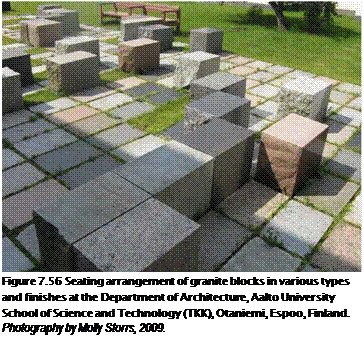Stone has been used to construct buildings for millennia but it also serves as a material for table surfaces, benches, decorative elements, and trim work (Figure 7.56).
 Marble is a beautiful stone; however, it is susceptible to breakage along its natural veins and faults. Though excellent in compression, it is fragile in both shear and moment capacity. It also needs to be sealed because it is easily stained and damaged by acids. Marble consists of calcium carbonate that is crystallized by metamorphism and ranges from granular to compact in texture. Typically, it is purchased in two slab thicknesses: 3/4 inch (2 cm) and 11/4 inches (3 cm). Slabs available for purchase are typically 5 feet x 10 feet (152 cm x 304 cm).
Marble is a beautiful stone; however, it is susceptible to breakage along its natural veins and faults. Though excellent in compression, it is fragile in both shear and moment capacity. It also needs to be sealed because it is easily stained and damaged by acids. Marble consists of calcium carbonate that is crystallized by metamorphism and ranges from granular to compact in texture. Typically, it is purchased in two slab thicknesses: 3/4 inch (2 cm) and 11/4 inches (3 cm). Slabs available for purchase are typically 5 feet x 10 feet (152 cm x 304 cm).
Limestone is also calcium carbonate, formed by seashells left behind millions of years ago. The shells formed sedimentary layers at the bottom of the ocean floor. Through a process called metamorphosis, they formed into limestone. Limestone, when further heat and pressure are applied, becomes marble.
Limestone and marble can be sanded, sawed, honed, and put on a lathe and turned. These stones are porous and will absorb moisture and oils. They need to be sealed and regularly maintained.
Granite is an igneous stone that results from volcanic activity. It is the hardest and most durable of the natural stones but still needs to be well supported. It is resistant to heat, moisture, acids, alkalis, and most chemicals. Granite receives its color by being combined with other minerals. Cobalt makes blue, iron makes red and black, and copper makes green granite.
Though granite is durable, it is a porous material and prone to developing bacteria within its surface. Therefore, it is not ideal for commercial food service applications. Popular synthetic stones, acrylic surfacing materials, and stainless steels are common substitutes for granite counters in food service or kitchen environments.
Stones can be cut and sculpted using a CNC machine. With the influx of digital software and digital modeling programs, stones can be worked in any imaginable manner using three-, four-, and five-axis milling machines.



